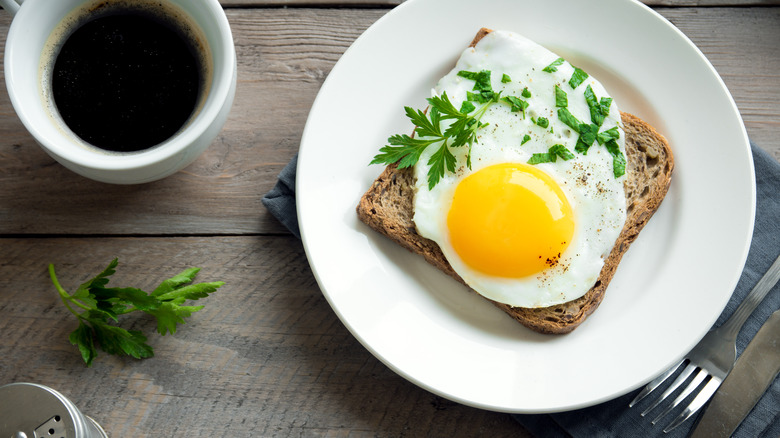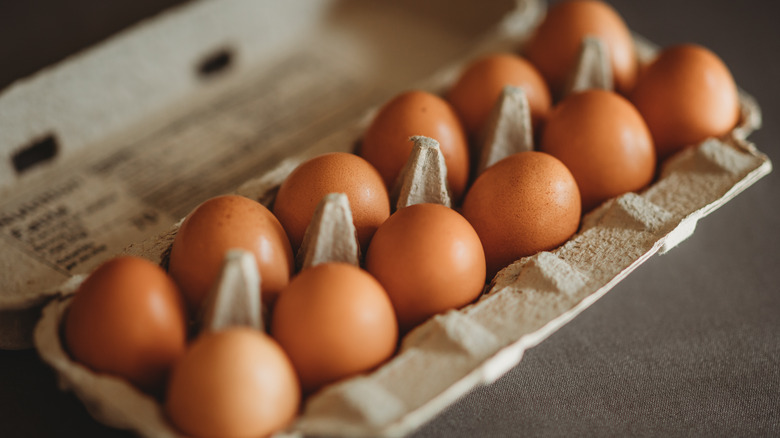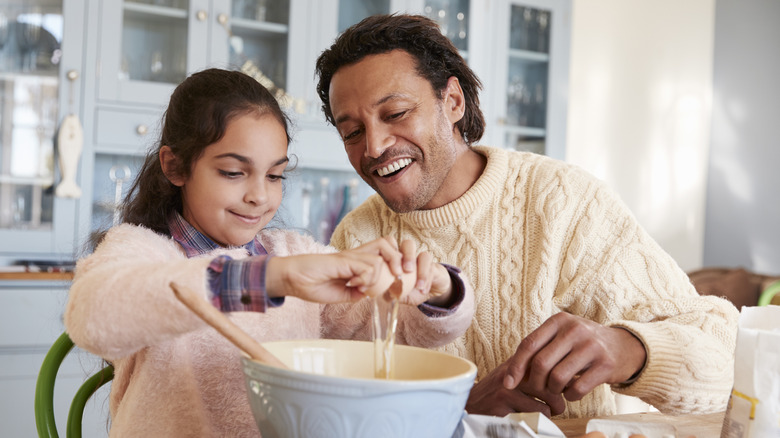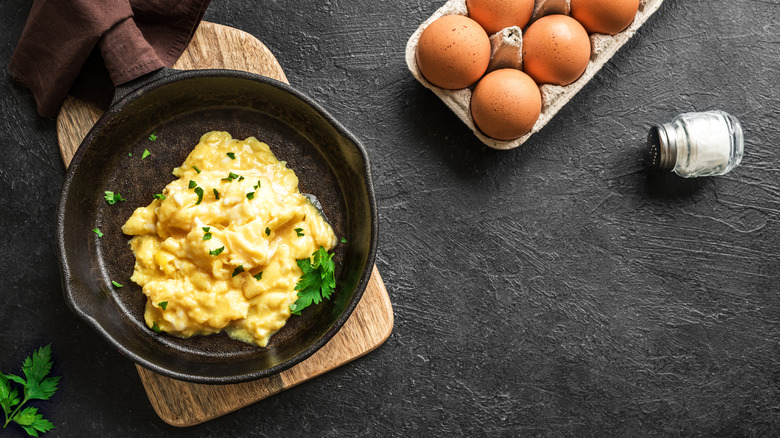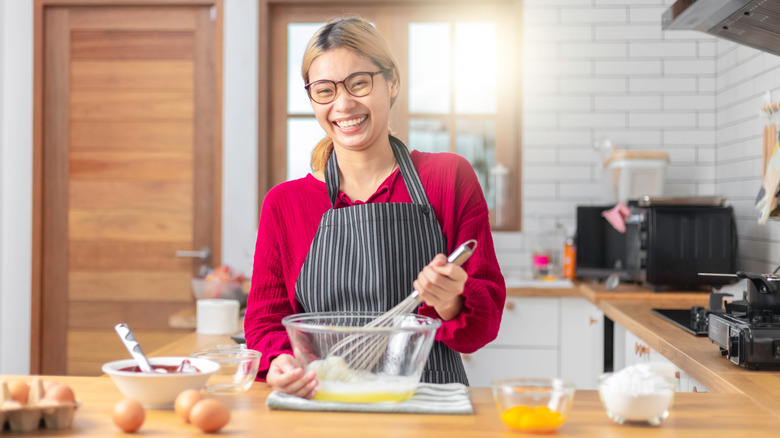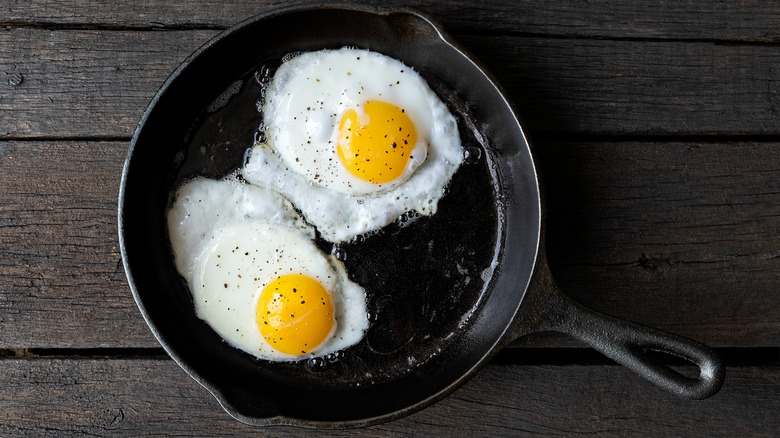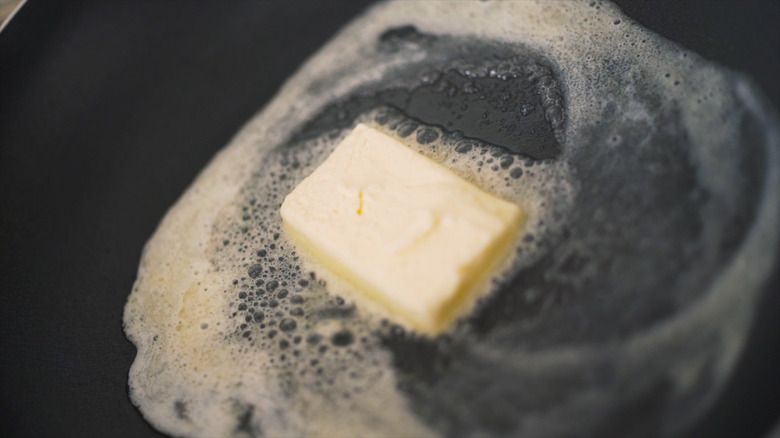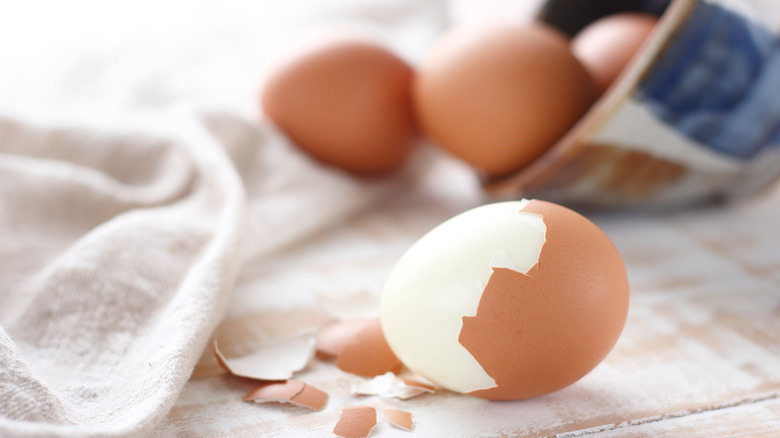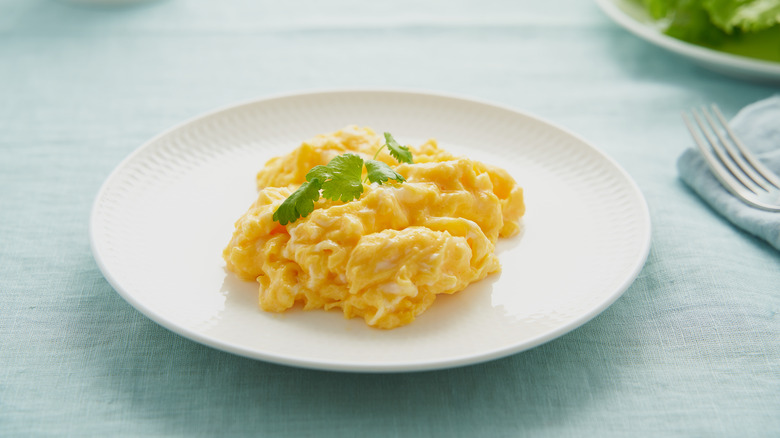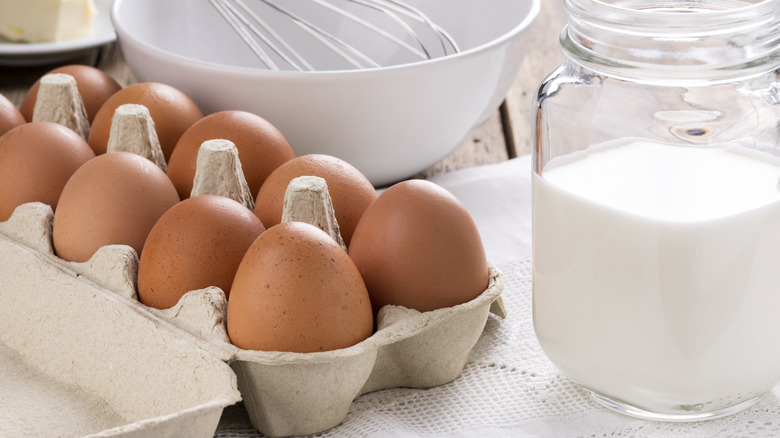The Biggest Mistakes You're Making With Eggs
Eggs are the gift that keeps on giving. According to BBC Good Food, they're flooded with protein and vitamins. They can be cooked in a million different ways — or that's at least how it seems. And they only take a few minutes to make –– traditionally, that is. Did we mention they taste mouthwateringly delicious? But even though eggs might be simple to make, there are likely many mistakes you're making while concocting them. Mistakes you didn't even know you were committing in the first place.
There are many forms of eggs — from scrambled to deviled and from Benedict to sunny-side-up. Though salt and pepper aren't necessary for a savory egg eating experience, seasoning the item always helps bump it up in the taste department. Though we don't necessarily consider ourselves egg-making connoisseurs, we know quite a bit about this cherished breakfast food. (We have, after all, been around the skillet.) With that in mind, follow along to see the biggest mistakes made when cooking eggs. Who knows, you could learn a thing or two!
1. Not using room temperature eggs when you're frying them
We know what you're thinking. Why would the temperature of eggs matter before cooking them? After all, they're going to be cooked in a frying pan, right? While fresh-out-of-the-fridge eggs could still lead to an adequate scramble, chef Robert Irvine advises letting eggs sit out and reach room temperature will ensure that they don't steam when frying. With that said, if you put a little bit of water into the pan while making sunny-side-up eggs and then place a lid on the pan, it'll allow the tops to cook yet still leave the yolk runny (via The Kitchn). Eggs are complicated.
If the eggs aren't cooked at room temperature, a cold egg could take longer to cook thoroughly. That's because the egg white will struggle to leave its runny stage, which could lead to the yolk overcooking (via The Guardian). There aren't many breakfast mistakes quite as bad as an overcooked egg, especially if you like dipping your bread or potatoes into a perfectly-made egg center.
2. Cracking eggs on the mixing bowl
Face it: We've all cracked eggs on the rim of a mixing bowl. And many times, the eggs turned out just fine. Yet this process is an egg mistake you probably didn't even know you were making. If you're not supposed to crack eggs on the mixing bowl, then where are you supposed to break them open? Simple. On the countertop. According to The New York Times, Jacques Pépin explains this eliminates any chance of bacteria reaching the bowl, which is especially important if you mix other ingredients in your egg bowl. It could also –– dare we say –– lead to eggshell fragments making their way into the bowl. Plus, cracking eggs on a bowl can break the yolk.
A flat surface is, by all means, the ideal place to crack your eggs –– if you want to eliminate bacteria, broken shells, and possibly fractured egg yolk. Nevertheless, there are certainly worse food crimes.
3. Overcooking your scrambled eggs
Eggs are a beautiful, delectable food –– at least when they're cooked to *chef's kiss* perfection. Make the wrong move, such as overcooking your eggs, and you might as well eat flavorless rubber (we don't endorse eating flavorless rubber.) The key is to not cook your eggs at too high of a temperature as this could lead to the egg white cooking faster than the yolk, per Mashed.
The trick? Turn the temperature down to medium heat. It's as simple as that. This same concept should, of course, apply to cooking scrambled eggs. Though it's important to thoroughly cook your scrambled eggs, firing up the stove too high could lead to eggs that are either dry or cooked too fast. Not to mention, if the heat is too high, it's harder to control how the eggs cook as they could cook too quickly (via Well+Good). You want your eggs to cook evenly, but that isn't easy to control when the heat is blazing. We understand you're hungry and craving some eggs, but there's no reason to rush a process that already doesn't take too much time.
4. Cooking eggs until they're finished
It only makes sense to cook food, especially eggs, all the way through. In other words, you want to cook eggs until they're finished. But alas, if you cook eggs until they're fully finished, you could overcook them, leading to that dry and lifeless texture that turns a good egg into a bad one. So how do you get around this egg blunder?
You take the eggs off the heat when they're slightly undercooked, Well+Good explains. The logic behind this? Eggs continue to cook with residual heat. By the time the eggs go from pan to plate to table to mouth, they should be fully cooked –– yet not overcooked and dry. The result? Perfectly fluffy eggs that taste like a top chef made them. Only a top chef didn't make them –– you did and in the comfort of your kitchen. While cooking the perfect egg by this point might seem like a culinary miracle, these mistakes are easily corrected.
5. Not whisking your scrambled eggs enough
We're not trying to nitpick (okay, maybe just a little) or rain on your egg parade, but if you're not whisking your scrambled eggs enough, then, well, you're probably not making those restaurant-quality eggs. The key is to fully whisk them in a bowl before making their way to the pan, per The Spruce Eats. The idea behind this is that the whisking process creates air, leading to fluffy eggs. It's *egg* science.
There might be more steps to making cloud-like eggs than you previously thought. Just remember, while you want to ensure your scrambled eggs are thoroughly whisked, you'll still need to pull them off the heat before they are fully finished, as they'll continue to cook in the residual heat. However, you could follow this step and still not make the egg of your dreams –– if you don't use a nonstick pan, that is.
6. Not using a non-stick pan
The nonstick vs. cast iron vs. stainless steel pan debate is never-ending. We're not here to solve that dilemma. Yet we are here to say that, if you're cooking eggs, then the choice is simple –– a nonstick pan is the go-to option. If an egg sticks to the pan, then the egg can break. Though a nonstick pan might not be ideal for searing, this type of pan can allow your fried eggs to easily slide around on the pan's nonstick surface, which is what we aim for, according to Gear Patrol.
Properly cooked eggs need to come out of the pan cleanly. And nonstick pans, for better or worse, give eggs the best chance at achieving this feat. While you might not use a nonstick pan for all of your cooking endeavors, they are a no-brainer when eggs are involved. Other pans, such as stainless steel or cast iron, could lead to sticking, though even that could be left up for debate in the cooking world.
7. Not using enough fat while cooking the eggs
We know what you're thinking: If a non-stick pan leads to eggs not sticking to the pan, then why would it matter how much fat is used for cooking eggs? It's a valid question, especially since fat tends to be associated with an unhealthy diet, per Mashed. (Though it's much more complicated than that as there are "good" and "bad" fats, and everyone is uniquely different, resulting in different food lifestyles.)
Outside of coating the pan so the eggs have very little chance of sticking, using a lot of fat (A.K.A. butter) can lead to a tastier egg. Cooks can also use the extra butter swimming in the pan to splash the butter on the egg (via Lifehacker). Though not everyone craves large amounts of fat, using a plethora of butter can help the eggs not stick to the pan and cook more thoroughly –– and taste even better. There are countless ways to make eggs, yet this is just one of the steps that could lead to an even more satisfying breakfast.
8. Cracking eggs directly into the water during poaching
Though there's plenty of debate on properly poaching eggs, cracking the eggs directly into the water during the poaching process can lead to an egg travesty. The result is the egg breaking apart from the yolk and the egg whites becoming watery, which doesn't sound appetizing.
But there's still hope. According to MyRecipes, after boiling a pot of water, you'll turn down the heat and then bring the temperature to a brisk simmer. As bubbles form, you'll then crack the egg into a small bowl instead of directly into the water. Yet MyRecipe also recommends using a spoon to create a whirlpool in the water –– and then you can drop the egg into the pot.
Though we believe in your poaching abilities, crafting a properly poached egg is a feat in itself, even when you follow all the correct steps. So if you opt only to enjoy your poached eggs at a restaurant, we don't blame you. Yet, as always, practice makes perfect.
9. Removing hard-boiled egg shells immediately after cooking
Making hard-boiled eggs doesn't come without its questions as it's so easy to under or overcook them. Plus, the moment you believe they're done, temptation lurks its head, and you want to peel the hard-boiled eggs immediately. You may or may not have heard of an egg ice bath, but the thought process behind this trick is simple. Hard-boiled eggs continue to cook inside their shell, so it's important to place them in an ice bath after they're done with the boiling process. This method is also supposed to make it easier to peel the eggs as it separates the outer egg from the shell, per Mashed.
Though there's plenty of debate on how long one should wait before peeling a hard-boiled egg (not to mention when an egg should be dropped into the water), an ice bath is typically the desired path as it ensures the egg doesn't continue to cook in its shell. And have you ever tried to peel a just-boiled egg? Talk about burned hands.
10. Seasoning scrambled eggs at the wrong time
Yes, even the way you season an egg can be considered a mistake. Some people believe seasoning scrambled eggs before cooking is the correct method, while others think you shouldn't season scrambled eggs until after the cooking process begins. Some cooks even season scrambled eggs after the eggs are finished, adding more flavor. The more flavor, the better, at least in some circles.
That said, the idea behind seasoning eggs while whisking them is that it leads to softer scrambled eggs, according to Bon Appétit. The seasoning has more time to wor itself into the egg, creating more robust flavors. It's recommended to add salt 15 minutes before cooking them. Whether you have that much time to wait for something that cooks as fast as eggs or not, seasoning your scrambled eggs before you start cooking them can lead to better results. Who knew cooking eggs could be so messy ...
11. Adding milk or cream to your scrambled eggs
Adding milk or cream to your scrambled eggs is supposed to make them fluffy. And as we all know, fluffy scrambled eggs are worth the price of admission. However, if you're using eggs in which the yolk's color is orange instead of yellow, milk or cream isn't necessary. Though your taste buds might disagree, adding extra ingredients such as milk can remove the eggy flavor. Milk can also change the texture and lead to a rubbery texture. As you would be adding liquid to the eggs, milk could also lead to your eggs becoming runny, resulting in you overcooking them as you try to cook off the liquid. The goal is to make fluffy eggs.
But alas, for every chef that opts for no milk/cream, there's another chef who adds some form of cream to scrambled eggs. Above all else, as long as your eggs aren't overcooked, you should be in pretty good hands. While eggs might seem like an easy food to make –– and they can be with practice accompanied by a whole lot of patience –– they're actually experimental and heavily debated. Here's to the perfect egg!
